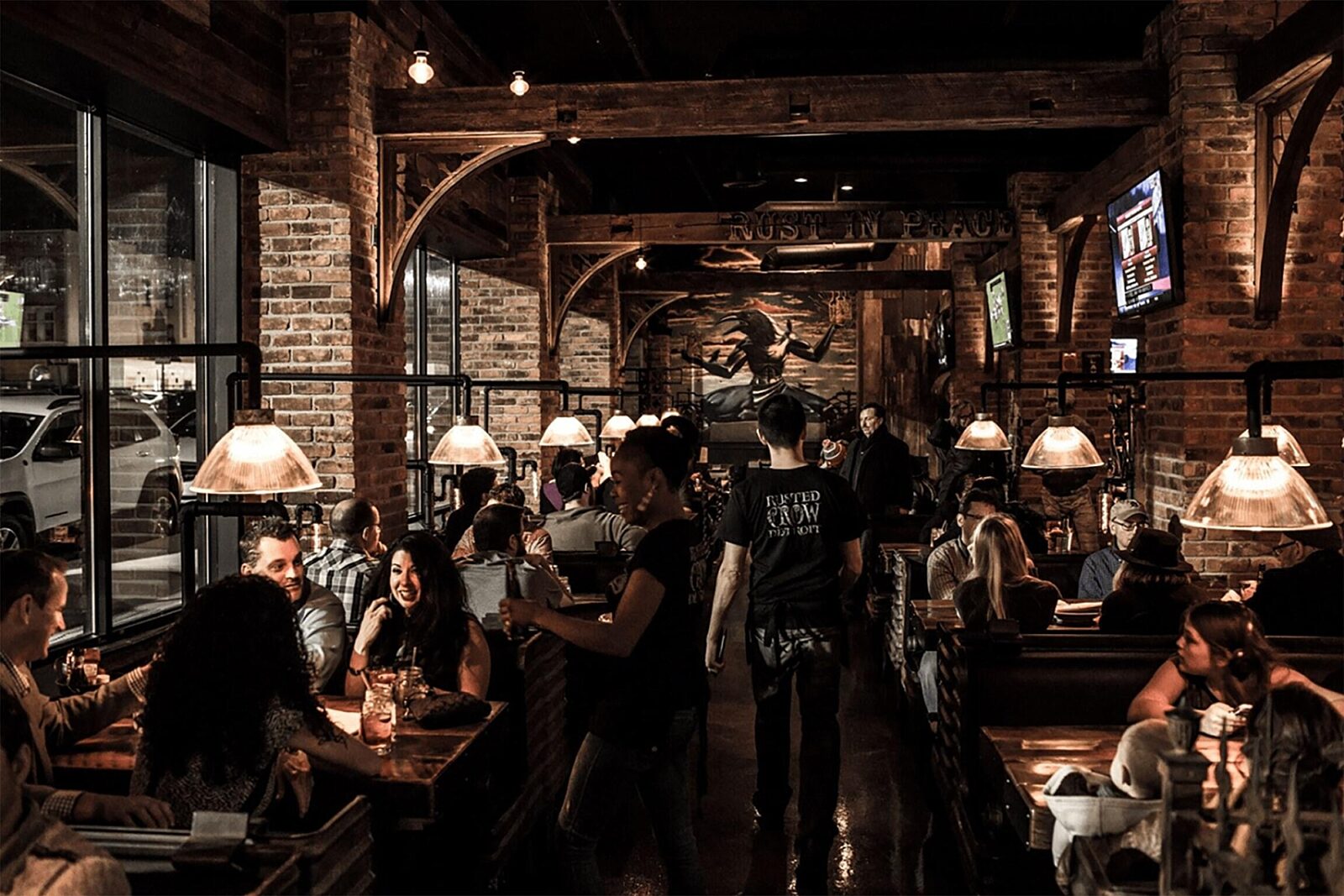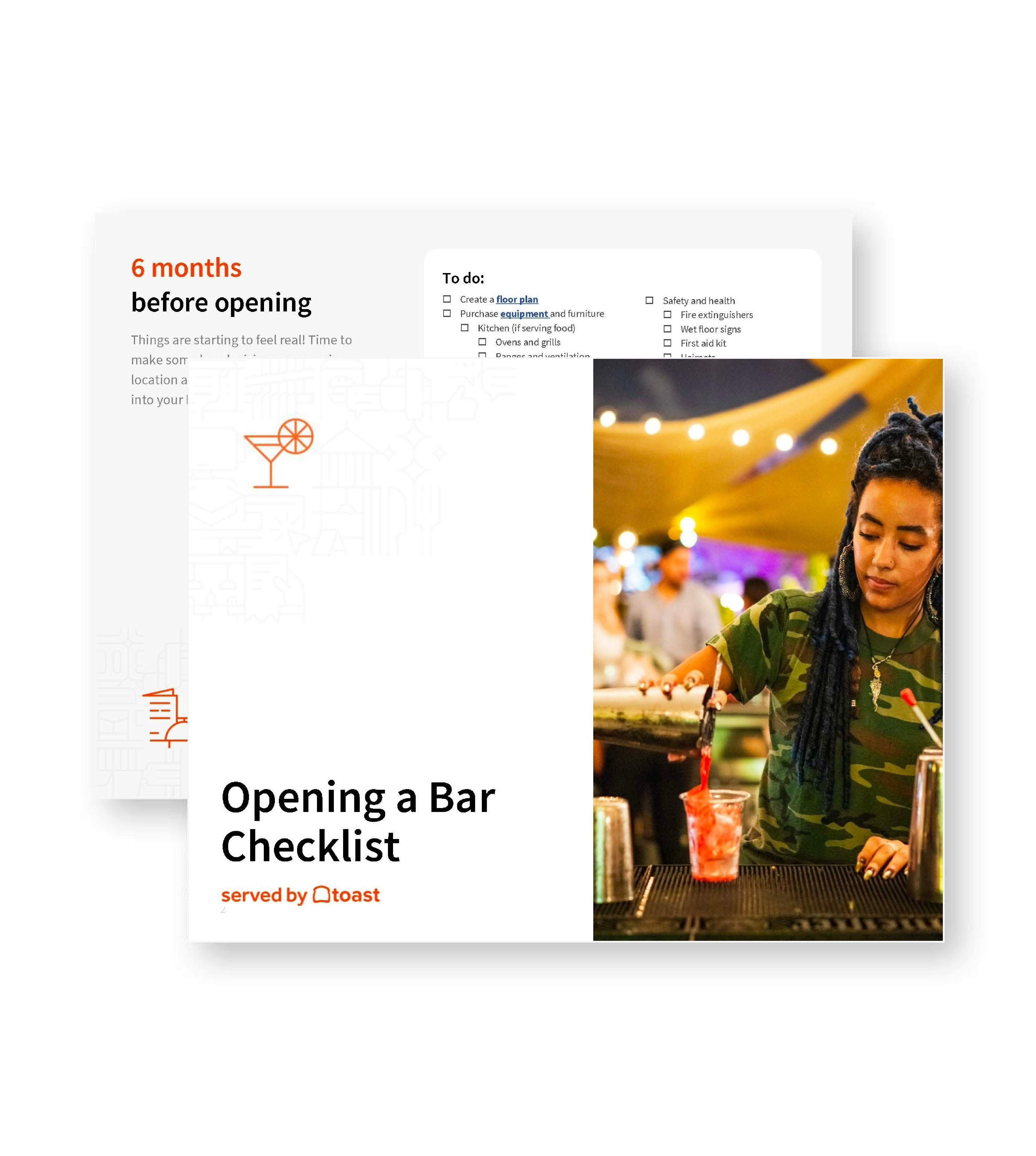
How to Run a Successful Bar: 8 Running a Bar Business Tips (2024)
Running a bar isn’t easy, but with the right people by your side and the right tools and processes, you can build a successful bar business.

Katherine BoyarskyAuthor


Opening a Bar Checklist
So many things go into opening a bar. With this free PDF checklist, you'll set your new business up for success.
Get free downloadHow to Run a Bar: 8 Running a Bar Tips
There’s a reason it’s a cliche for a group of friends sitting at a bar to say “hey… what if we bought a bar?” It’s an exciting industry, and owning a bar means you will never be bored again. You’ll be working weekends and evenings for the foreseeable future. There will always be a lot of challenging and tedious work to be done by you and your team, just like in any other hospitality business.
Now don’t be discouraged - when you love your team and clientele, owning a bar can be a fun way of life. One big reason so many bar owners stay in it for the long haul is the connections they make in their community, the rewards of training and keeping a great team, and, of course, the substantial profits.
We’ll get into everything you need to know about running a bar, from managing costs and increasing revenue to getting the word out about your business. Brand-new bar owners with no experience will learn the foundations of a bar’s operations, and longtime bar owners can get some new ideas to improve their bottom line and their business's long-term health.
8 Tips for Managing & Optimizing Key Bar Operations Costs
Managing Rent and Overhead
Reviewing and negotiating your lease is a critical early step in your journey of owning a bar. It’s important to balance the excitement of finding the perfect space and location while doing the due diligence to keep your recurring costs as low as possible.
Overhead includes all the baseline costs of doing business that have nothing to do with creating a product or providing a service. These costs include rent, electricity, gas, water, internet, admin/legal, and insurance. Keep an eye on these costs, especially the variable ones like utilities, regularly.
Stay On Top of Licenses and Find a Trusted Lawyer
Running a bar requires a liquor license and many other types of permits, too. Look into the guidelines for your local jurisdiction to ensure you’re applying for the permits you need as early as possible.
It’s always good to have a great lawyer, especially in the early stages of opening a bar. They can be a valuable resource as you move through your permitting process and overcome any issues that arise. Ask for help early whenever you face a legal problem – it’s a worthy investment.
Find, Train, and Retain the Best Bar Staff — and Pay Them Well
Your bar won’t be able to function without an amazing bar team. Bartenders come to mind first, but you’ll also need barbacks, managers, dishwashers, bussers, and maybe even cooks if you serve food. Finding a great team can be tough in today’s competitive job market. Therefore, offering good pay and meaningful benefits is essential.
For new bars, it’s crucial to build good pay for your team into your business plan from day one. And, for longtime bar owners figuring out how to make ends meet while increasing staff pay and providing benefits, look at other successful businesses like Thamee, Thai Fresh, and Juliet. These restaurants and bars have made it work by increasing menu prices, experimenting with different staffing models, trying out service charges, and getting down to the nitty-gritty of their costs.
In addition, it's vital to have a safe work environment with robust safety policies for your staff, as they’ll be working around alcohol and drunk people daily. Employees who feel comfortable and supported at work are happy. Remember - your people are your business’s biggest investment, so take care of them.
Track Cost of Goods Sold and Pour Cost Often
Monitoring food and beverage costs is the key to maintaining healthy margins. With inflation ballooning prices of virtually everything, from liquor to napkins to ice machines, it’s more important than ever to negotiate with vendors. Don’t be afraid to rethink menu and drink items that aren’t pulling their weight or are costing too much to make it through menu engineering.
According to BinWise, the ideal pour cost per drink is 20%. Here’s how they calculate the cost of a simple cocktail that uses $2 worth of ingredients to make:
Drink Price ($) = Ingredient Cost ($) / Ideal Pour Cost (%)
Drink Price ($) = 2 / 0.20
Drink Price = $10
If you notice that your ingredient costs go up, as should the price.
Market your Bar and Run Bar Promotions
Bar marketing is critical to the success of almost every type of bar — even cash-only dive bars have social media pages these days. So, get the word out about your bar and any events or promotions you’re running! Try out various marketing channels like social media, email marketing, paid ads, and flyers in your neighborhood to see what works best for you.
Create the Perfect Atmosphere with Great Interior Design
Your bar’s design should reflect the overall feel of your business. Is it grungy or divey with great prices and snacks? Elegant and modern with innovative cocktails? A local pub? A dance bar? Define your bar brand and decorate it accordingly. Add lighting, art, furniture, paint, and decor that align with your vision.
Your online presence should also match your interior design. More often than not, your customers engage with your business online before they set foot in the door. Your online presence can be your ticket to making a cohesive first impression.
Invest in Professional Services
You can’t do it all alone. Repairing a dishwasher, filing complex business taxes, draining your grease trap, and handling legal matters are only a few examples of tasks you might need help with at your bar. Ask your peers who they’ve worked with to resolve issues and use their recommendations to help you find professional partners who can help your business for years to come.
Get the Best Bar Technology and Equipment
Pen and paper can only get you so far. By embracing technology and bringing on the best bar point of sale platform for your business, you can reduce operational inefficiencies, manage your team, keep an eye on costs and inventory, and learn from all the data your business generates.
How to Successfully Run a Bar With No Experience
Take time to learn from your peers. Before you sign on the dotted line, meet with several restaurant and bar owners in your neighborhood. Learn the nuances of running a business in your area, from suppliers to work with, to local trends and preferences, to landlords to avoid.
Soak up industry knowledge from the pros. If you’re starting from scratch and have never worked in a bar before, take a two-pronged approach. First, watch some videos and online courses about the basics of running a restaurant or bar business. Then, reach out to bar owners and ask if you can shadow them for a few days. You’ll learn so much about the industry and become better prepared for the challenges (and occasional chaos) that come with running a bar.
Treat your team like the gems they are. Once you’ve hired your first team members, do everything in your power to ensure they feel supported and happy in their work. After all, they may be the ones showing you the ropes sometimes. They’re also the ones that will be connecting with your customers, creating and embodying the environment of your bar, and providing great drinks and service.
How Longtime Bar Owners Improve How They Run Their Bars
Tips for growing bar sales and improving margins
Bar marketing. Getting the word out about your bar is one of the easiest ways to grow your sales, and there are so many different avenues to try. Posting regularly on your bar's social media pages, starting an email newsletter, sponsoring a local event, hosting live music or events, and engaging with your community are all great places to start. Try one at a time and track what works best for your bar.
Inventory management. Keeping an eye on inventory and supplier prices is an important part of managing margins, especially given how volatile the market is now. Software like xtraCHEF can track changes in supplier prices and alert you, helping you figure out the next step.
Promotions. Promotions require a delicate balance. You need to offer enough to entice new and returning customers while not too much to dent your margins significantly. A free appetizer during happy hour, half-price drinks on Monday and Tuesday evenings, or an irresistible shot-and-a-beer combo are just a few examples. Just like with marketing channels, try one at a time and see what attracts more customers and do more of that.
Upselling. Staff should be encouraged to lead customers to try a higher-end liquor or a new, pricier menu item.
Partner with a neighboring restaurant. Offer snacks or desserts from a restaurant down the street.
Tips for managing bar costs while increasing revenue
Don’t shy away from data. Make use of your bar POS’s reporting and analytics dashboard, where you can see trends like which days of the week need more staff, which promotions are working, and how your business is doing this month compared to last month and compared to last year.
Stay on top of inventory. Manage supplier relationships, track price changes, and prevent food waste with a great inventory platform.
Check on your menu. Even a drinks-only menu can benefit from menu engineering, where you determine the profitability and popularity of each item and find the ones that generate waste and drag your profits down.
Increase prices. Most customers understand that given the current economic situation, restaurants and bars must increase their prices to stay profitable. Include a note on your menu for longtime customers to explain the price increases.
Control shrinkage. This term refers to the difference between liquor sold and liquor poured. Train staff to pour standard pours every time, or, especially for liquor bottles, invest in bottle stoppers that measure the correct amount of liquor. You might be shocked to see how much you save.
Restaurant Metrics Calculator
Use this free calculator to calculate the key restaurant metrics needed to understand the health and success of your business.

Operating Costs Breakdown and Benchmarks for Successful Bars
It takes between $100,000 and $850,000 to open a bar, but once you’re open, operating costs can vary just as widely.
A small dive bar with 24 seats, a small staff, and a menu of mostly draft beer and rail drinks will have significantly lower costs than a 100-seat high-end mezcal bar with a patio.
But what makes bar businesses attractive is that liquor markups are so much higher than the markup on food and ingredients. These margins can make both types of bars very successful and profitable. Some bars can also manage with fewer staff members than restaurants since they don’t have full kitchens. In other words, they can pay staff well while still keeping their labor costs in check.
BinWise highlights that bars are much more profitable than restaurants, with a 10-15% profit margin on average. That’s three times higher than the average for restaurants.
Bars tend to have five major categories of recurring operational costs:
Labor cost
Liquor cost (and food cost, if there’s a menu)
Overhead
Professional services
Technology
Labor cost is typically 30-35% of revenue in the hospitality industry generally. However, it can be lower in small bars. Liquor, beer, and wine costs range between 15% and 40% of total sales (with liquor on the low end and wine on the high end). Hospitality utilities tend to take up another 5% of revenue. Location costs, professional services, technology, and other overhead costs vary from business to business.
That means the dive bar mentioned previously might have prime costs (labor plus food/beverage costs) of around 55%, leaving a good amount of wiggle room available to cover all other expenses and still pocket some profit. This is in sharp contrast to restaurants that often only have 28% of revenue or less left over to cover everything else.
The high-end mezcal bar with a patio might have higher labor and liquor costs, but since they charge so much more, they can keep to those similar profit margins.
How to Stay Up to Date on Bar and Beverage Industry Trends
Social media. Follow similar businesses in your city, and also follow hashtags on Instagram and Tiktok related to your niche, whether it’s #mixology and #divebar or #naturalwine, #tequila, and #cocktailbar. Social media channels are an excellent way to track what guests love in your area.
Read industry publications. Online resources like On the Line, Eater, NRN, BinWise, and Food & Wine offer tons of free news and updates on the bar industry.
Have conversations. Talk to your peers and go to their bars! There’s so much you can learn from others around you.
Keep Your Bar Business Booming
Owning a bar can bring a lot of chaos, but with the right systems and technology and a great team by your side, you’ll get to have fun at work every day and connect with your community —and make some profit, too.
Related Restaurant Resources
Restaurant Metrics Calculator
Use this free calculator to calculate the key restaurant metrics needed to understand the health and success of your business.

Is this article helpful?
DISCLAIMER: This information is provided for general informational purposes only, and publication does not constitute an endorsement. Toast does not warrant the accuracy or completeness of any information, text, graphics, links, or other items contained within this content. Toast does not guarantee you will achieve any specific results if you follow any advice herein. It may be advisable for you to consult with a professional such as a lawyer, accountant, or business advisor for advice specific to your situation.
Subscribe to On the Line
Sign up to get industry intel, advice, tools, and honest takes from real people tackling their restaurants’ greatest challenges.
